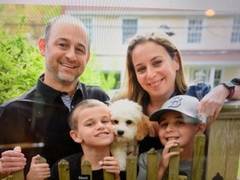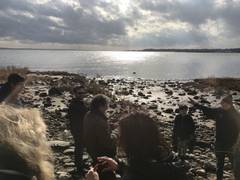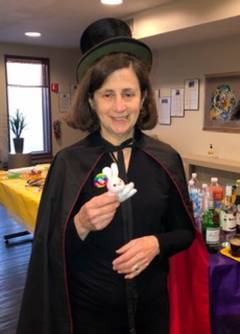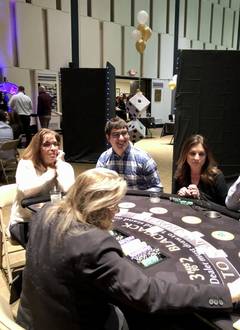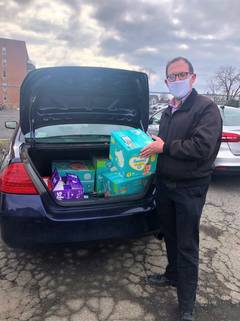yizkor 2024: The Claimant's Stone
10/15/2024 04:45:13 PM
Rabbi Ben Goldberg
| Author | |
| Date Added | |
| Automatically create summary | |
| Summary |
Today, we think of Yom Kippur as one of, if not the most, important of the Jewish holidays. Yet, Yom Kippur may once have functioned as a prelude to the holiday that follows five days later: Sukkot. The purpose of Yom Kippur was to purge the Temple of the accumulated spiritual schmutz–the technical term is tum’a–of the previous year. This way, the Temple was prepared and ready for the week-long Sukkot festival, with its many sacrifices, ceremonies, and massive crowds who came on pilgrimage.
It must have been quite something to be present for the Sukkot pilgrimage in ancient Jerusalem, full of farmers who came from all around the land of Israel to mark the end of the harvest and to anticipate the upcoming rainy season. They were days of rejoicing and anxiety, celebration and reverence.
This massive pilgrimage surely must have presented its share of logistical challenges. Tradition records that, somehow, miraculously, there was always enough room in Jerusalem for the pilgrims to stay the night. The pilgrimage also presented another logistical problem, one that remains with us: lost and found. Surely in the commotion, some pilgrims must have misplaced their belongings.
The Talmud records the procedure for dealing with lost items during the Pilgrimage on Sukkot and the other two pilgrimage festivals. Anyone who found a lost item would spread word of the discovered object for a full cycle of three holidays, plus seven days, enough time for the owner to return home, realize the item was missing, and get back to Jerusalem.
There was a place in the Temple complex set aside for this purpose, known as the even to-en, or the Claimant’s Stone. Anyone who lost an item, and anyone who had found an ownerless item, would be directed to this stone. The finder would announce the find, and the owner would state the item’s identifying features in order to claim it.
I find it striking that at the heart of the most sacred and charged space in ancient Jerusalem was a place for people to tell stories of their losses. A place for people to say: I had something, and I lost it; and a place for others to say: Yes, you lost something. That really happened to you, and it matters. Let me try to help you find it. Let’s see if we can make each other whole again.
I thought of the Claimant’s Stone when I visited what has become known as Hostages Square in Tel Aviv. Before October 7, this was an unremarkable plaza that served as the entryway to the Tel Aviv Museum of Art. Located across a busy road from IDF headquarters, in the days and weeks following October 7, this space became a focal point for efforts to support the hostage families and to advocate for the release of those held in captivity.
The square quickly filled with ever-changing public art exhibits, including the dining table with a place setting for each hostage. Booths around the square were dedicated to the different kibbutzim whose residents were in captivity. In a large tent, relatives of the hostages told their stories to whomever was there to listen. I’m proud that the Conservative movement’s Israeli branch, known as Masorti, has taken a lead role in bringing Jewish observances to the square in an open, pluralistic, and egalitarian manner.
Before my visit, a few people had given me token amounts of tzedakah to donate while in Israel, as is customary. I decided that the square is where I wanted to donate those funds. So I approached a table where volunteers were selling hostage-awareness merchandise, asked if I could simply donate, and struck up a conversation in Hebrew. The woman I was speaking to expressed surprise that I am a rabbi–”You don’t look it,” she said–but also reported that she had met people from all over the world who had come to Hostages Square to hear the stories and express their solidarity.
Hostages Square emerged organically. No official decided to turn over the space for this purpose. It emerged anyway because of a deep need to have a place where losses could be acknowledged publicly. Those who had lost loved ones to captivity and desperately sought their return needed it, of course. But the rest of us needed that space, too. We–Israelis, Diaspora Jews, and others from around the world–needed a place to go to acknowledge this loss, to deal with our own feelings, but also to support those even more directly impacted. We needed a Claimant’s Stone, and one appeared.
The original Claimant’s Stone did not last forever. It was destroyed along with the rest of the Temple complex by the Romans. What happened in the absence of that space? The Sages declared that lost items would be announced in synagogues and study halls. This was yet another function these institutions took over from the destroyed Temple. We could no longer gather centrally in Jerusalem, but we could gather in those smaller places, the mikdash me’at, or the small sanctuary, as tradition labeled the local synagogue.
But then, the Talmud relates, oppressors proliferated. Jews no longer lived entirely under their own legal and value systems, which, as we’ve seen, require extraordinary measures to return lost objects. Instead, they lived under Persian law, which assigned all lost objects to the king’s ownership, or Roman law, which operated under the principle of “finders-keepers". Jewish values on this subject became counter-cultural, dangerously so, and thus Jewish law shrunk its geography of care. Now, one who found a lost item would simply inform their immediate neighbors and acquaintances, rather than making a big show of trying to return the lost object, as would ideally be the Jewish way.
We collectively get lost when we lose the place to announce lost things. We lose our sense of who we are and what distinctively matters to us. We lose the ethic of care and concern for others that is at the heart of who we are as a people, as inheritors of a tradition that sees every human being as an image of God. We cannot fully be ourselves without the times, spaces, and structures to announce our losses and to acknowledge others’ losses.
One of those structures, perhaps less familiar to us, is the ethical will or tzava’a. This is a document where a person approaching death would convey the ethical lessons they most wished to impart on their surviving children or students. These documents are a way for people to participate in their own mourning process. They, in a sense, pre-announce a loss before it has occurred, enabling the deceased to have a voice in the mourning process that will follow their demise.
While there is some biblical precedent for this, ethical wills flourished in the medieval period, and the ethical wills of famous rabbis were widely circulated, well beyond their intended, small audience. These documents provide moral guidance and articulate the deceased's wishes for how their survivors would go on without them. They are also, understandably, saturated with emotion and piety. For example, the great scholar Nachmanides wrote: “My son, remember me always, and let the image of my countenance be never absent from before your eyes. And love not that which I hate.”
Ethical wills have experienced a revival in contemporary Jewish communities, and you might consider writing your own, both as a spiritual exercise in values clarification and also as a document to actually leave behind. There are great resources to help with this; please contact me if you are interested.
This year, however, also saw an emergence of ethical wills written by people who are too young to have written them. As Israeli soldiers were called up to fight in this war that has dragged on and on, many of them wrote ethical wills, final notes to their family and friends. These were found after their death in combat, in their uniform pockets or in the Notes app on their phones. Some of these wills were composed at the soldiers’ own initiative; other times, commanders instructed their soldiers to write these wills, which also communicated the risk they were facing. While each, of course, is unique, collectively they reveal a sense of dedication to mission, an understanding that the death they were contemplating served a purpose greater than themselves.
Of course, they all would have preferred to survive, and to not have needed to fight. But they accepted the possibility of their deaths as a sacrifice they willingly made for the sake of their family, friends, and country. These wills express the strength of values, of purpose, that enabled these young people to face the prospect of their own death with fortitude and composure.
Consider this ethical will composed by Sergeant First Class Ben Zussman, who was killed in battle last December in Gaza, at the age of 22:
“I'm writing this message to you on my way to the base. If you're reading this, something probably happened to me. As you know me, I'm likely the happiest person right now. It's not for nothing that I was about to fulfill my dream soon. I'm happy and grateful for the privilege I'll have to defend our beautiful country and the people of Israel.
“Even if something happens to me, I don't allow you to sink into sadness. I had the privilege to fulfill my dream and destiny, and be sure that I'm looking down at you from above with a huge smile. I'll probably sit next to Grandpa and catch up, each of us sharing our experiences and how things have changed between wars. Maybe we'll also talk some politics, ask him what he thinks.
“If, God forbid, you're sitting shiva, turn it into a week of friends, family, and fun. Have food, meat of course, beers, sweet drinks, seeds, tea, and definitely Mom's cookies. Laugh, listen to stories, meet all my other friends you haven't met yet. Really? I'm jealous of you. I'd like to sit there and see everyone.
“....I left home without even being called up for reserve duty. I'm full of pride and a sense of mission, and I've always said that if I need to die, I hope it will be in defense of others and the country. Jerusalem, I have set watchmen, may the day come when I'll be one of them.”
Ben’s letter is heartbreaking, and inspiring in his commitment to his core ideals such that he could contemplate giving over his life for their sake. And–I wonder about all of the letters like this that were written, but no one ever read, because their authors survived. I have to imagine that many of Ben’s peers have, tucked away in drawers or in the recesses of a phone’s data, similar letters that, thank God, never needed to be read. And I wonder: did the experience of writing it change the writer? Does the urgent need to convey what is most important, what we’d most want our loved ones to know about our deepest values and concerns, change the way we live afterward?
An answer to this question might be found in what you could call an unintended ethical will. I had the opportunity this summer to meet, through Daniel, a woman named Rotem Azar. Rotem’s brother Guy was murdered at the Nova Festival along with several friends, at just 23 years old. By all accounts, he was an extraordinarily thoughtful and positive young man who had just begun a promising career in fashion.
Guy could never have imagined when he went to that music festival that he might not come back. He did not write what he knew could be his last words to his loved ones. But, he did leave behind the lock screen of his phone, which was a picture of what he called the “Rules of Happiness.” They were how he tried to live his life, which he put on his phone’s lock screen so he could be constantly reminded of them.
Guy’s rules of happiness are:
Don’t hate.
Live simply.
Expect little.
Don’t worry.
Always smile.
Give a lot.
Love a lot
Enjoy the moment.
You fell? Get up!
Remember: God is always by your side.
Guy lived by these rules of happiness throughout his short life. His family has embraced his unintended ethical will as his legacy. Rotem hands out little magnets with these rules printed on them to everyone she meets, as a way to spread her brother’s positive attitude around the world. Guy’s life demonstrates that taking the time to articulate what is most important to us can, in fact, profoundly change how we live and how we are remembered.
I’ve often referred to Yom Kippur as a manufactured near-death experience. This day is meant to force us to confront our mortality, such that we can then consider what is most important to us. Ben Zussman and the other fallen soldiers had a clear sense of what was more important to them than life itself. Guy Azar knew the bedrock principles around which he approached every situation in his life.
Do we? And can this sacred day of self-denial help us figure it out?
With that question in mind, we turn to our Claimant’s Stone: Yizkor. This is our place to announce, to ourselves and to the supportive community around us: I’ve lost something. Let me tell you about it. And it’s a space for the rest of us to say: Yes, you’ve lost something. It’s not OK. Let me listen to you talk about it. Let me dry your tears. Let us try to make each other something approaching whole. Let us consider the legacy left to us by past generations, and the legacy we wish to transmit to those who will come after us.
Yizkor: may we remember in thought and in deed.
Update this content.
Tue, October 21 2025
29 Tishrei 5786
Photo Gallery
Photo Albums
Upcoming Events
-
Wednesday ,
OctOctober 22 , 2025Rabbi, May I? Modern Responsa
Wednesday, Oct 22nd 10:00a to 11:30a
Wednesdays, 10 - 11:30 AM, KTI Library Ever since Abraham’s famous argument with God, Judaism has been full of debate. Moses and Korah, David and Nathan, Hillel and Shammai, the Vilna Gaon and the Ba’al Shem Tov, Spinoza and the Amsterdam Rabbis . . . the list goes on. No wonder that Judaism cherishes the expression machloket l’shem shamayim, “an argument for the sake of heaven.” Beyond their historical importance, what makes these disputations so compelling is that nearly all of them, regardless of their epochs, are still being argued. The parade of characters spanning three millennia of biblical, rabbinic, and modern disputation reflects the panorama of Jewish history with its monumental political, ethical, and spiritual challenges. This series will examine Jewish responses to exile from the biblical period to our modern day. Considering texts from all genres of Jewish literary creativity, we will explore how the realities and iterpretaions Join as we re-open these timeless debates that lead us to the core of 3,000 years of Jewish conversation. • Justice: Abraham vs. God (October 19) • Holiness and Authority: Moses vs. Korah (November 9) • Inclusion: The Five Daughters vs. the Twelve Tribes (November 30) • Accountability and Morality: David vs. Nathan (December 21) • Resistance: Ben Zakkai vs. the Zealots (January 18) • Law: Hillel vs. Shammai (February 15) • Spirituality: The Vilna Gaon vs. the Baal Shem Tov (March 15) • Boundaries: Spinoza vs. the Amsterdam Rabbis (April 19) • Religious Evolution: Geiger vs. Hirsch vs. Frankel (May 10) • Zionism: Herzl vs. Wise (May 31) -
Wednesday ,
OctOctober 22 , 2025Wrestling with God
Wednesday, Oct 22nd 8:00p to 9:30p
Wrestling with God Wednesdays, 8-9:30 PM Congregants’ homes TBA We need to talk about God. And about how we talk, and don’t talk, about God. It’s a big topic, maybe the biggest. This offering invites adult learners into compassionate inquiry, deepening their relationship to Jewish text through collective exploration. Using the album s*ngs ab-ut g?d [https://open.spotify.com/album/6JEY2AN6awAxNfWwmXX460] by Jewish educator Eliana Light as a starting point, this series blends music, Hebrew text study, and open-ended questions to help participants examine their own connections to the divine. This is sacred work. It’s not about getting it right. It’s about showing up with curiosity, humility, and a willingness to join the long lineage of Jews who wrestle with God. Each session stands alone, but we’d love to have a consistent group as much as possible. Dates: September 10: skyman October 22: shadows November 19: in the silence December 10: if only January 21: lead me back February 11: three steps March 11: beyONEd April 29: the mountains May 20: the name June 17: I rise -
Thursday ,
OctOctober 30 , 2025Coffee with the Rabbi
Thursday, Oct 30th 8:00a to 9:00a
Start your morning with some caffeine and casual or meaningful conversation! Join Rabbi Goldberg for a Coffee Chat! Stop by Rye Ridge Starbucks any of the following Thursdays, between 8-9am: June 12 and 26 July 10 and 24 August 7 and 21 September 4 and 18 October 16 and 30 November 6 and 20 December 4 and 18 -
Saturday ,
NovNovember 1 , 2025Dror Israel Shabbat
Shabbat, Nov 1st 11:30a
Dror Israel Shabbat Dror Israel’s Mirit Sulema, along with two leaders of the Arab Youth Movement NOAL, Tal Tunik and Shadi Habiballa, will speak during a Kiddush lunch about their important work with Arab Israeli youth and bringing Jewish, Arab, and Druze youth together. Saturday, November 1st, approx. 11:30am KTI Social Hall "We eat together, laugh together. We talk about what we think of each other, and what will help bring peace.” RSVP Appreciated -
Saturday ,
NovNovember 1 , 2025KTI Gala - A November to Remember Digital Journal
Motzei Shabbat, Nov 1st 7:00p to 10:00p
Privacy Settings | Privacy Policy | Member Terms
©2025 All rights reserved. Find out more about ShulCloud

